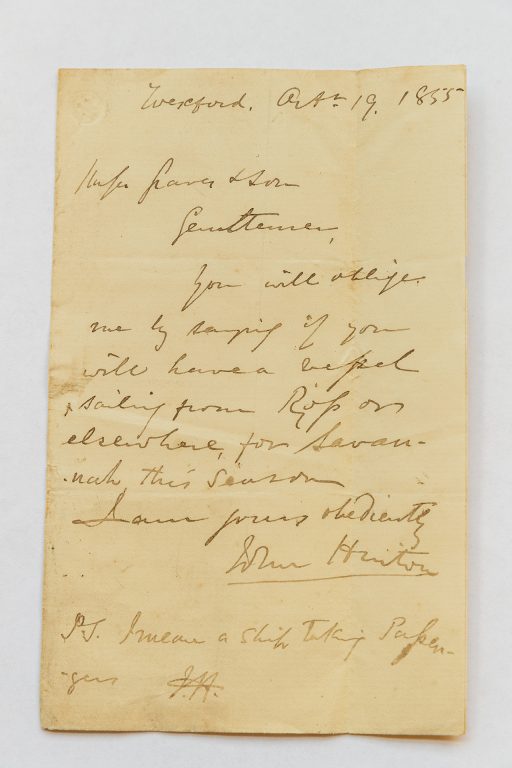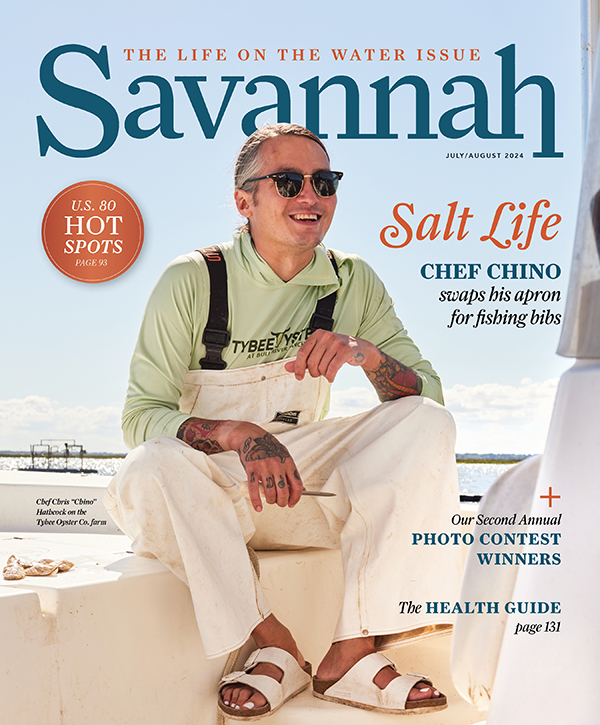Wexford Irish Pub will showcase Savannah’s centuries-old connection to Ireland through historical mementos and intentionally sourced materials and fixtures
Written by COLLEEN ANN MCNALLY
“WE’VE BEEN THINKING SAVANNAH should have a high-end Irish pub for a long time now,” says Jennifer Strickland. A lifelong Savannah resident, she and her brother, Tim, grew up in the family business, River Street Sweets, which they continue to lead 50 years later.
When Kevin Barry’s Pub closed on River Street in 2019 after 39 years, the sibling team, along with their partner, Chris Swanson, knew Savannah would miss having the jovial gathering place. “Our family was friends with Vic Power, who owned Kevin Barry’s forever,” says Jennifer. “We didn’t want to do the same kind of pub as Vic in deference to him. We wanted to do something a little bit different and we wanted to find an elevated look and feel for an Irish pub that told the story of why the Irish and St. Patrick’s Day are such a big deal in Savannah.”
Once the building at the Barnard and West Congress Street corner of City Market (that formerly housed Wild Wings Cafe) became available, the Stricklands jumped. With a space and a general concept in mind, they started zeroing in on their research to create an experience that would be authentically Savannah. “We are history nerds about Savannah in general,” says Jennifer.

One day, Tim stumbled upon the work of Dr. Howard Keeley, director of the Center for Irish Research and Teaching (CIRT) at Georgia Southern University and the story of the Wexford-Savannah Axis — a joint research project between the John F. Kennedy Trust, Waterford Institute of Technology, Wexford County Council, Georgia Southern University and Georgia Historical Society that is digging into the unique migration and integration and the Irish diaspora in the American South. Since 2013, the project has discovered information surrounding the many voyages that occurred between Wexford and Savannah from the late 1840s to the early 1860s, such as the Dunbrody Famine Ship passenger database with records of thousands of Irish emigrant families arriving in Savannah.
“Oh my gosh, that’s it,” Jennifer recalls first thinking when her brother suggested Wexford Irish Pub as the name for their new venture. But before making it official, they reached out to Keeley to gain his Irish blessing, so to speak.
As luck would have it, Keeley simultaneously was looking for creative ways to further bring his students together with the community, embracing the concept of a university without walls.
MAXIMUM IRISHNESS
“Savannah has a very special Irish heritage and quite an old one,” Keeley says. “Savannah is, especially in February and March, certainly an Irish city. Its heartbeat is a green heartbeat.” Yet, he says often people come up short in explaining how this heritage began. Like its proprietors, Keeley saw the pub as an opportunity to educate locals and visitors alike about the enduring link between the coasts of Southeast Georgia and Southeast Ireland.
According to Keeley, the city reached an apex of “maximum Irishness” between 1848 and the mid-1850s. “The city already had an Irish-born population, but that doubled during that period,” he says. Of those direct migrants, an estimated 56% came from Wexford — making it the most represented county of all the 32 traditional Irish counties that are represented in Savannah. “You could say that Savannah is the most Wexford city in the United States.”

During this period, Ireland suffered from the Potato Famine. However, research shows the true catalyst behind the axis was trade — as was the case with the voyage of the Dunbrody, the first Wexford ship that arrived in Savannah in the spring of 1846.
“Savannah was not just exporting cotton and rice. There was also a lot of timber exports, and that’s what Ireland needed,” says Keeley, who credits the discovery from former student James Devlin, who found the ship’s loading document in an uncatalogued box in the National Archives of Ireland.

In exchange, the ships were originally bringing ballast stones to Savannah, which contributed to the cobblestones and walls along River Street. Eventually, as people became more desperate or eager to leave Ireland, the shipping companies began bringing people instead. In turn, the Hostess City embraced them — which wasn’t always the case in other American cities.
“If we look at Irish migration into Boston or New York, a lot of Irish had a really tough time. They were discriminated against,” Keeley says. “That did not happen in Savannah, even though it was a majority Protestant city, and the vast majority of Wexford immigrants were Catholics.”
He adds that Wexford people quickly built a reputation for being hard-working, enterprising and reliable — a brand that was helped by some extraordinary immigrants, including William Kehoe of Kehoe Iron Works and Kehoe House; Daniel O’Connor, an ancestor of Flannery O’Connor and who had one of the city’s largest carriage works; Michael Cash, who built the wall at Factor’s Walk; and Richard Joseph Nunn, who was influential in health care for African Americans.

PINT-SIZED HISTORY LESSONS
When Wexford Irish Pub opens in June, guests will see mementos of this history brought to life.
With help from Darren Fagan of the Irish Pub Company (the same firm behind Fadó Irish Pub in Atlanta), the Stricklands have intentionally sourced millwork, stained glass and other fixtures directly from Ireland for the interior design, along with elements unearthed throughout the Wexford-Savannah Axis research project. “We’re doing storytelling through beautiful, visual artifacts,” Keeley says, adding there will be QR codes for guests who want to learn more.

To deepen their own knowledge and ensure an authentic experience, in 2023, the Stricklands hosted delegates from the Wexford City Council during Savannah’s St. Patrick’s Day parade and also spent time in Ireland. During their visit, Jennifer was struck by the similarities between both places — not only among the coastal views but also the friendly spirit and pride in their home. “The people are so welcoming, happy and kind. That gets passed on,” she says, noting her grandfather was Irish. “Mom always said it’s like familiarity. So many Irish people act like you’re long-lost friends.”
And the Stricklands are certainly no stranger to Savannah’s hospitality scene. In addition to River Street Sweets, the family also currently owns riverfront staples The Shrimp Factory, River House Seafood, The Warehouse Bar & Grill and Lizzy’s Burger Bar & Grill as well as Churchill’s British Pub on Bay Street. While Jennifer promises Wexford Irish Pub will deliver the same quality service as their other restaurants, she says this project is particularly special because it’s the first one they’ve designed “from the ground up.”
Plans for the menu and live music programming also draw inspiration from the Stricklands’ visit abroad. Of course, there will be plenty of Guinness — served both in pint glasses and in the dishes, such as mussels in a Guinness cream sauce.
Still, Keeley is quick to point out that the true Irish pub experience is about much more than beer. “A pub is a place to go and be in community. It’s a kind of living room,” he says, noting that a stout is best enjoyed slowly over conversation. “A pub is not a place to go and get drunk out of your tree or shout. It’s a calm place, and it’s welcoming — where people who are strangers can get to know each other.”




THE INFINITE AXIS
Although centuries in the making, in some ways, the Savannah-Wexford connection is stronger than ever. In 2019, Georgia Southern became the first public university in the United States to establish a learning center in Ireland and the CIRT — which began as a one-room operation more than two decades earlier — continues to grow.
“Wexford’s nickname is the Model County,” Keeley says, describing the community as innovative and progressive with their sleeves rolled up and a can-do attitude. “There’s this sense that they aren’t going to let down the team. I think Savannah is like that as well. We have this world-class port, world-class filmmaking, world-class aerospace and world-class hospitality. When people in Savannah decide to do something, they do it right. That’s like Wexford. It’s in the blood.”
Looking ahead, Keeley says the CIRT is planning more ways to share the Irish history of Savannah — including more narratives of women, African Americans and people from counties outside Wexford — through future walking tours, historical markers, virtual reality, educational outreach to local schools and more.
And this St. Patrick’s Day, the Stricklands will again host delegates from the Wexford City Council during Savannah’s bicentennial parade and surrounding festivities — a favorite tradition for the Irish Savannahians.
“To us, St. Patrick’s Day is always about family and friends and camaraderie,” Jennifer says. “It’s just a part of the fabric of everyday life here.”




